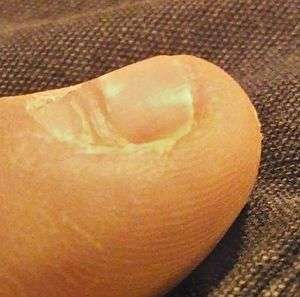Beau's lines
Beau's lines are deep grooved lines that run from side to side on the fingernail or the toenail. They may look like indentations or ridges in the nail plate.[1]:657 This condition of the nail was named by a French physician, Joseph Honoré Simon Beau (1806–1865), who first described it in 1846.
| Beau's lines | |
|---|---|
 | |
| Beau's lines on the middle fingernail of the left hand caused by a severe paronychia infection | |
| Specialty | Dermatology |
Signs and symptoms
Beau's lines are horizontal, going across the nail, and should not be confused with vertical ridges going from the bottom (cuticle) of the nail out to the fingertip. These vertical lines are usually a natural consequence of aging and are harmless.[2][3]
Beau's lines should also be distinguished from Muehrcke's lines of the fingernails. While Beau's lines are actual ridges and indentations in the nail plate, Muehrcke lines are areas of hypopigmentation without palpable ridges; they affect the underlying nail bed, and not the nail itself. Beau's lines should also be distinguished from Mees' lines of the fingernails, which are areas of discoloration in the nail plate.
Causes
There are several causes of Beau's lines. It is believed that there is a temporary cessation of cell division in the nail matrix. This may be caused by an infection or problem in the nail fold, where the nail begins to form, or it may be caused by an injury to that area. Some other reasons for these lines include trauma, coronary occlusion, hypocalcaemia, and skin disease. They may be a sign of systemic disease, or may also be caused by an illness of the body, as well as drugs used in chemotherapy, or malnutrition.[4][5] Beau's lines can also be seen one to two months after the onset of fever in children with Kawasaki disease.[6]
A researcher found Beau's lines in the fingernails of two of six divers following a deep saturation dive to a pressure equal to 305 metres (1,001 ft) of sea water, and in six of six divers following a similar dive to 335 metres (1,099 ft).[7] They have also been seen in Ötzi the Iceman.
Human nails grow at a rate which varies with many factors: age, and the finger or toe in question as well as nutrition. However, typically in healthy populations fingernails grow at about 0.1mm/day and toenails at about 0.05mm/day.[8] With this in mind the date of the stress causing Beau's lines and other identifiable marks on nails can be estimated.
See also
References
- Freedberg, et al. (2003). Fitzpatrick's Dermatology in General Medicine. (6th ed.). McGraw-Hill. ISBN 0-07-138076-0.
- Google Answers: Vertical Ridges, citing several different studies and experts. Accessed April 7, 2009.
- Mayo Clinic: Vertical Ridges. Accessed April 7, 2009.
- Ben-Dayan D, Mittelman M, Floru S & Djaldetti M (1994). "Transverse nail ridgings (Beau's lines) induced by chemotherapy". Acta Haematol. 91 (2): 89–90. doi:10.1159/000204261. PMID 7517608.
- Park J; Li K (2010). "Multiple Beau's lines". New England Journal of Medicine. 362 (20): e63. doi:10.1056/NEJMicm0906698. PMID 20484394.
- Fimbres AM, Shulman ST. Kawasaki Disease. Pediatr rev 2008;29;308-316.
- Schwartz H (2006). "Clinical observation: Beau's lines on fingernails after deep saturation dives". Undersea Hyperb Med. 33 (1): 5–10. PMID 16602251. Retrieved 2009-02-16.
- Yaemsiri S, Hou N, Slining M & He K (2009). "Growth rate of human fingernails and toenails in healthy American young adults". Journal of the European Academy of Dermatology and Venereology. 24 (4): 420–423. doi:10.1111/j.1468-3083.2009.03426.x. PMID 19744178.
External links
| Classification |
|---|